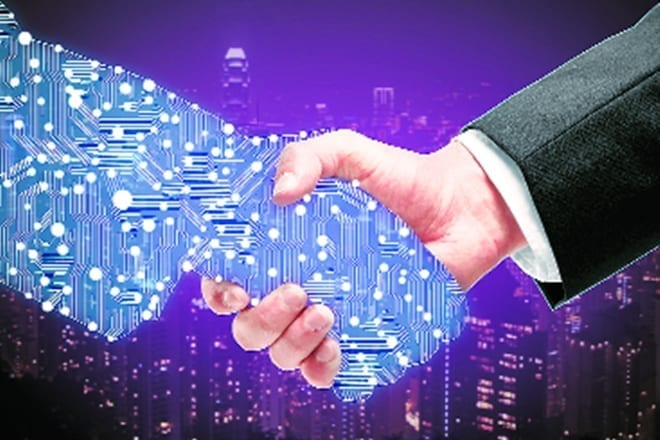Emerging technologies will underpin the formation of new human-machine partnerships that make the most of their respective complementary strengths
By Rajesh Janey
We live in a digital era, where, most of the human mobility needs are being met by a simple app. With technology providing what people need, when they need it and wherever they need it, the day is not far when it might even become hard to justify maintaining a car or any piece of equipment that’s rarely used. Digital technologies are part and parcel of our everyday lives. These connect people when they are need in of a particular service, for example, we can now book a cab or book flight tickets, easily, within minutes with the help of various apps. We live in times where technology has already started to work as an extension of people’s needs, helping orchestrate, manage, and automate many day-to-day activities. These digital technologies will be integrated with machine learning to create a population of digital orchestration systems, harnessing technology to arrange and direct resources to produce a desired result.
Human-machine partnerships will not only help automate and coordinate our lives, but they will also transform how organisations find talent, manage teams, deliver products and services, and support professional development. Over the next decade, emerging technologies such as artificial learning, machine learning and deep learning, will underpin the formation of new human-machine partnerships that make the most of their respective complementary strengths. This provokes us to think creatively about the future possibilities—and potential pitfalls—generated by the next era of human-machine partnerships. Let us explore some of these possibilities across verticals.
Media & entertainment
The next era of human-machine collaborations and co-dependencies may reshape how people spend their leisure time. It will influence the way we consume media and participate in live events as these partnerships will intersect with explosive growth in video game play and e-sports viewership to re-invent the fan experience. Let us imagine an athlete, say in 15 years, whose scholarship depends on his performance at a particular game. He will not just be concerned about the millions of spectators that will watch him play. However, he will be acutely focused on his 1.2 million ‘connected fans’ whose feelings of excitement, disappointment, anticipation, and jubilation he will be able to feel literally. His ‘connected fans’ will be outfitted with clothing, jewelry, or even an ingested technology that can create feedback loops between the fans and the athlete. If the majority of his ‘connected fans’ are happy with his play, he’ll feel a rush of good will. Fans, linked directly to the athlete’s bio-psychological data streams will be fully informed of his emotional state, as well.
Feeling the emotional data of game play is not the only aspect of haptic and sensory computing experienced by these ‘connected fans.’ Some of his most fearless fans link up directly with the game characters. As a result, they feel the elation of flying, leaping, and successfully battling the game’s foes. Of course, they also intimately experience the characters’ missteps—crashing, smashing, and getting punched in the stomach.
Healthcare
The digital health market is projected to top $200 billion by 2020. Our new roles as digital conductors will lead to in-the-moment learning and on-demand care within the health care industry, as these partnerships will reshape the way medical information is shared, diseases are treated, and new therapies are discovered. Suppose a young girl, say Alicia is suffering from asthma. For years, she has depended on her indoor air quality monitoring system and her smart inhaler to track the environmental conditions around her. These tools, linked up first to her smart phone and later to her smart wearable, have helped refine her understanding of what triggers outbreaks, and anticipate when she might be at risk of another attack. However, over the last few years, Alicia’s tracking devices have served only to confirm what everyone already knows: increased incidences of asthma all over the world are the result of changes to the global climate.
If her condition would worsen, she would simply order an in-home doctor’s visit through her on-demand medical app when she was unwell. It’s now 2030 and it is possible that she has decided to post her symptoms to a crowdsourcing platform on which people work collaboratively to provide health advice and treatment guidance based on their personal experiences or professional training. A number of the medical ‘detectives’ on the platform could recommend genetic testing and suggest sending the test results to an AI system for evaluation.
Financial services
In 2030, financial AI systems would be routinely purchasing and managing their own financial products, cutting time, costs, and security concerns with each transaction. Self-driving cars, for example, would be automatically searching the markets for the optimal insurance policies, performing real-time analysis of all the relevant information pertaining to individual trips and risks. Similarly, home security systems would be rationally increasing their own coverage against theft autonomously when a neighborhood experiences an increase in crime rates.
An employee, working in this industry would be benefitting from the financial knowledge of the system. The digital system that works alongside the employee would constantly observe all the human traders in an attempt to better mimic the professional tricks it has not yet mastered. At the same time, the employee would watch the system’s activities, because, while the system is undeniably brilliant, there is something radically novel about its way of thinking. To conclude, over the next decade, emerging technologies will underpin the formation of new human-machine partnerships that make the most of their respective complementary strengths. These partnerships will enhance people’s daily activities, coordination of resources and in-the-moment learning, which will reset expectations for work and require corporate structures to adapt to the expanding capabilities of human-machine teams.
The writer is president & MD, India Enterprise, Dell EMC



